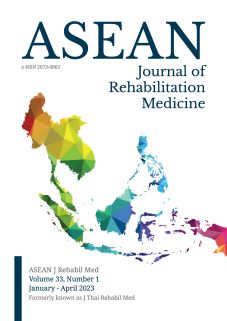Comparison of Effectiveness, Patient Satisfaction, and Durability between 3D-Printed Customized Insoles and Conventional Custom-Made Insoles for Flat Feet: A Randomized Controlled Trial
Keywords:
flat feet, foot orthoses, 3D-printed customized insoles, conventional custom-made insoles, patient satisfactionAbstract
Objectives: To compare foot and ankle function, patient satisfaction, and insole durability between 3D-printed customized insoles and conventional custom-made insoles for the treatment of flat feet.
Study design: A randomized controlled trial.
Setting: Siriraj Hospital, Mahidol University, Bangkok, Thailand.
Subjects: Sixty Thais with bilateral flat feet.
Methods: Participants were randomized into either the 3D-printed insole group (study) or the conventional insole group (control). The effectiveness of both types of insoles was compared using the visual analog scale foot and ankle (VAS-FA) score to evaluate foot and ankle function, navicular height, and participant insole use to evaluate insole durability. Patient feedback was used to evaluate patient satisfaction.
Results: Patient characteristics and baseline VAS-FA score were comparable between groups. The median change (range) in VAS-FA score from baseline to the third month score was 1.5 (-6.3, 68.0; p = 0.002) in the study group and 4.0 (-6.5, 35.0; p < 0.001) in the control group. Mean and standard deviation change in the deformation of insoles in the third month were as follows: right side in the study group: 0.2 (0.3) cm (p = 0.010) and in the controls: 0.2(0.3) cm (p < 0.001); left side among study group 0.1 (0.2) cm (p = 0.005) and in the controls: 0.3 (0.4) cm (p = 0.001). In addition, the study group overall satisfaction score was significantly higher than the control group: 3.8 (0.4) vs. 3.3 (0.6), respectively (p < 0.001).
Conclusions: The VAS-FA scores significantly improved at three months in both groups. There was no statistically significant difference between the groups. Deformation of insoles was found in both groups with no significant difference between the groups. Measured durability and patient-reported satisfaction were both statistically significantly higher in the study group than in the control group.
References
Halabchi F, Mazaheri R, Mirshahi M, Abbasian L. Pediatric flexible flatfoot; clinical aspects and algorithmic approach. Iran J Pediatr [Internet]. 2013 [cited 2022 May30];23(3):247-60.Available form: https://pubmed.ncbi.nlm.nih.gov/23795246/
Lee MS, Vanore JV, Thomas JL, et al. Diagnosis and treatment of adult flatfoot. J Foot Ankle Surg [Internet]. 2005 [cited 2022 May 30];44(2):78-113. Available from: https://pubmed.ncbi.nlm.nih.gov/15768358/ doi:10.1053/j.jfas.2004.12.001
Arangio GA, Reinert KL, Salathe EP. A biomechanical model of the effect of subtalar arthroereisis on the adult flexible flat foot. Clin Biomech (Bristol, Avon) [Internet]. 2004 [cited 2022 May 30];19(8):847-52. Available from: https://pubmed.ncbi.nlm.nih.gov/15342157/ doi:10.1016/j.clinbiomech.2003.11.002
Kitaoka HB, Luo ZP, An KN. Three-dimensional analysis of flatfoot deformity: cadaver study. Foot Ankle Int [Internet]. 1998 [cited 2022 May 30];19(7):447-51. Available from: https://pubmed.ncbi.nlm.nih.gov/9694122/ doi:10.1177/107110079801900705
Tang CYK, Ng KH, Lai J. Adult flatfoot. BMJ [Internet]. 2020 [cited 2022 May 30];368:m295. Available from: https://pubmed.ncbi.nlm.nih.gov/32094144/ doi:10.1136/bmj.m295
Chaiphrom N, Rungprai C, Chuvetsereporn N. Prevalence and effect of flatfoot among army privates. J Southeast Asian Med Res [Internet]. 2017 Dec [cited 2022 May 30];1(2):70-3. Available from: https://www.jseamed.org/index.php/jseamed/article/view/29
Jafarnezhadgero A, Madadi-Shad M, Alavi-Mehr SM, Granacher U. The long-term use of foot orthoses affects walking kinematics and kinetics of children with flexible flat feet: A randomized controlled trial. PLoS One [Internet]. 2018[cited 2022 May 30];13(10):e0205187. Available from: https://pubmed.ncbi.nlm.nih.gov/30300405/ doi:10.1371/journal.pone.0205187
Jumani S, Memon ZA, Larik J. Process modeling of rapid manufacturing based mass customisation system for fabrication of custom foot orthoses: Review paper. Mehran Univ Res J Eng Technol [Internet]. 2013[cited 2022 May 30];32:183–96. Available from: https://www.semanticscholar.org/paper/Process-Modelling-of-Rapid-Manufacturing-Based-Mass-Jumani-Memon/19487759b4cec5ba86a4eb8005a3192d859f0187
Dombroski CE, Balsdon ME, Froats A. The use of a low cost 3D scanning and printing tool in the manufacture of custom-made foot orthoses: a preliminary study. BMC Res Notes [Internet]. 2014 [cited 2022 May 30];7:443 Available from: https://bmcresnotes.biomedcentral.com/articles/10.1186/1756-0500-7-443. doi:10.1186/1756-0500-7-443
Saleh JM, Dalgarno KW. Innovative developments in design and manufacturing: cost and benefit analysis of fused deposition modeling (FDM) technique and selective laser sintering (SLS) for fabrication of customized foot orthoses. 1st ed. CRC Press [Internet]. 2009 [cited 2022 May 29];723-28. Available from: https://www.taylorfrancis.com/chapters/edit/10.1201/9780203859476-122/cost-benefit-analysis-fused-deposition-modelling-fdm-technique-selective-laser-sintering-sls-fabrication-customised-foot-orthoses-saleh-dalgarno
Chen RK, Jin Y, Wensman J, Shih A. Additive manufacturing of custom orthoses and prostheses–a review. Addit Manuf [Internet]. 2016 [cited 2022 May 29];12:77–89. Available from: https://www.infona.pl/resource/bwmeta1.element.elsevier-79988ac0-1c14-3d5a-9862-3f9ac07a6a9d
Kim YK, Joo JY. Effects of custom-made 3D printed insoles for flat–foot people on gait parameters: a preliminary study. ISBS Proc Arch [Internet]. 2017 [cited 2022 May 29];35:195-8. Available from: https://www.semanticscholar.org/paper/EFFECTS-OF-CUSTOM-MADE-3D-PRINTED-INSOLES-FOR-ON-A-Kim-Joo/0815bf6266650560701b27e7b38a0c680cbd6901
Angthong C, Chernchujit B, Suntharapa T, Harnroongroj T. Visual analogue scale foot and ankle: validity and reliability of Thai version of the new outcome score in subjective form. J Med Assoc Thai [Internet]. 2011 [cited 2022 May 30];94(8):952-7. Available from: https://pubmed.ncbi.nlm.nih.gov/21863677/
Landorf K, Keenan AM, Rushworth RL. Foot orthosis prescription habits of Australian and New Zealand podiatric physicians. J Am Podiatr Med Assoc [Internet]. 2001 [cited 2022 May 30];91(4):174-83. Available from: https://pubmed.ncbi.nlm.nih.gov/11319247/ doi:10.7547/87507315-91-4-174
Ki SW, Leung AK, Li AN. Comparison of plantar pressure distribution patterns between foot orthoses provided by the CAD-CAM and foam impression methods. Prosthet Orthot Int [Internet]. 2008 [cited 2022 May 30];32(3):356-62. Available from: https://pubmed.ncbi.nlm.nih.gov/18677672/ doi:10.1080/03093640802016159
Paton JS, Stenhouse E, Bruce G, Jones R. A longitudinal investigation into the functional and physical durability of insoles used for the preventive management of neuropathic diabetic feet. J Am Podiatr Med Assoc [Internet]. 2014 [cited 2022 May 30];104(1):50-7. Available from: https://pubmed.ncbi.nlm.nih.gov/24504577/ doi:10.7547/0003-0538-104.1.50
Downloads
Published
How to Cite
Issue
Section
License

This work is licensed under a Creative Commons Attribution-NonCommercial-NoDerivatives 4.0 International License.






